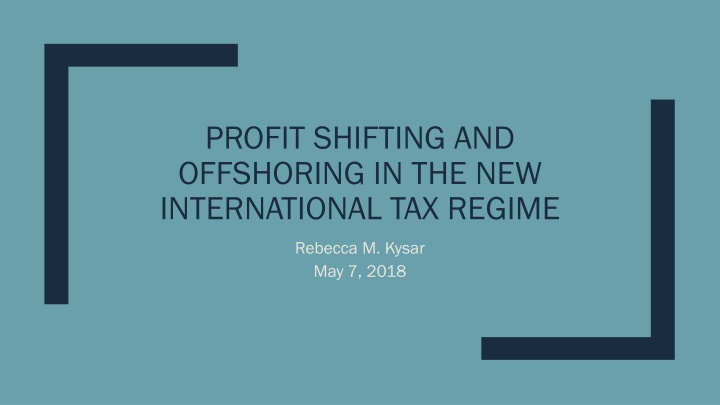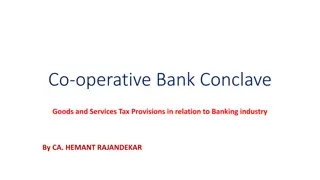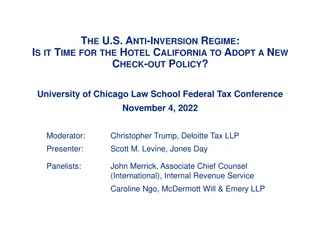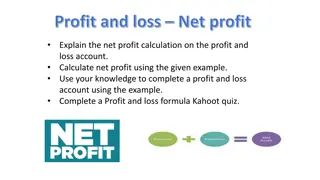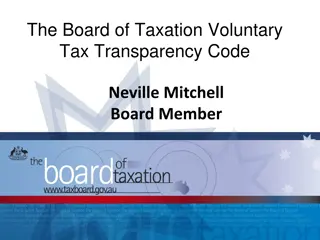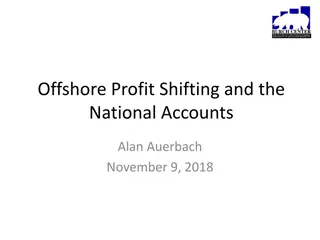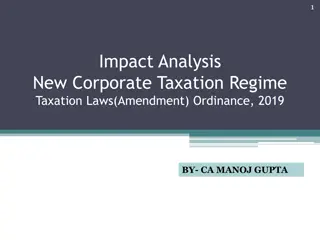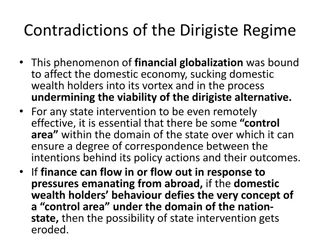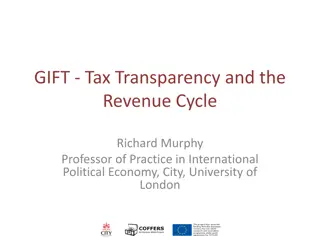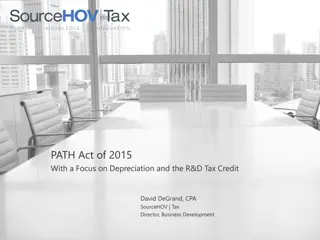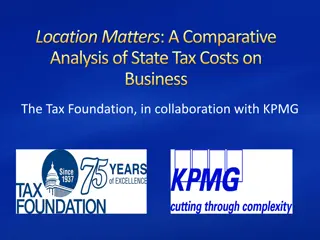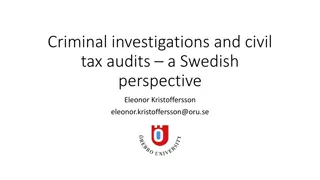Profit Shifting and Offshoring in the New International Tax Regime
Summary of changes in the 2017 International Tax Legislation that impact corporate rates, deductions, GILTI, FDII, and BEAT. The policy choices made incentivize asset offshoring while maintaining profit shifting opportunities.
Download Presentation

Please find below an Image/Link to download the presentation.
The content on the website is provided AS IS for your information and personal use only. It may not be sold, licensed, or shared on other websites without obtaining consent from the author.If you encounter any issues during the download, it is possible that the publisher has removed the file from their server.
You are allowed to download the files provided on this website for personal or commercial use, subject to the condition that they are used lawfully. All files are the property of their respective owners.
The content on the website is provided AS IS for your information and personal use only. It may not be sold, licensed, or shared on other websites without obtaining consent from the author.
E N D
Presentation Transcript
PROFIT SHIFTING AND OFFSHORING IN THE NEW INTERNATIONAL TAX REGIME Rebecca M. Kysar May 7, 2018
Summary of 2017 Intl Tax Changes Lower corporate rate to 21% Participation exemption system 100% deduction to U.S. corps for dividends received from certain (10% ownership or greater) foreign subsidiaries U.S. corporate shareholders assessed one time transition tax on pro rata share of untaxed E&P of certain (10% ownership or greater) foreign subsidiaries (15.5% for cash; 8% for non-cash) Tax on a current basis half of high return earnings from certain (10% ownership or greater) foreign corporations, aka Global Intangible Low Taxed Income or GILTI (effectively a 10.5% rate after a 50% deduction) New 37.5% deduction on exports, aka Foreign Derived Intangible Income or FDII (effectively a 13.125% tax rate after 37.5% deduction) New Base Erosion Anti-Abuse Tax (BEAT) imposed at 10% on deductible payments made by U.S. corporations to foreign affiliates
Summary 2017 tax legislation makes policy choices that unnecessarily incentivize the offshoring of assets, while largely preserving profit shifting
GILTI Policy choice of applying minimum tax on global rather than per-country basis encourages profit shifting.
Global v. Per Country Minimum Tax Income Income Foreign Taxes Foreign Taxes (assume 21%) (assume 21%) Tentative Tentative GILTI GILTI Liability Liability 80% credit for 80% credit for foreign taxes foreign taxes Final U.S. Final U.S. Liability Liability Total Tax (U.S. and Total Tax (U.S. and Foreign) Foreign) Country A 1,000,000 210,000 105,000 168,000 0 (excess credits are forfeited) 420,000 210,000 US Investment Combined Combined 2,000,000 N/A N/A N/A 420,000 210,000 105,000 168,000 420,000 630,000 630,000
Global v. Per Country Minimum Tax Income Income Foreign Taxes Foreign Taxes (assume 21 (assume 21% in Country A; in Country A; 0% in B 0% in B) ) 210,000 Tentative Tentative GILTI GILTI Liability Liability 80% credit for 80% credit for foreign taxes foreign taxes Final U.S. Final U.S. Liability Liability Total Tax (U.S. and Total Tax (U.S. and Foreign) Foreign) % Country A 1,000,000 105,000 168,000 0 (excess credits are forfeited 210,000 210,000 Country B Investment Combined using Per Country Minimum Tax Combined Combined using Global using Global Minimum Minimum Tax (current Tax (current law) law) 2,000,000 0 210,000 0 210,000 3,000,000 210,000 315,000 105,000 (capped by GILTI liability in Country A) 210,000 420,000 3,000,000 210,000 315,000 168,000 (not capped by GILTI liability in Country A) 147,000 (excess credits from Country A absorb Country B GILTI liability) 357,000 357,000 ( (as opposed to 630,000 as opposed to 630,000 if investment was made if investment was made in US and 420,000 in US and 420,000 under per country minimum tax per country minimum tax approach) approach) under
GILTI Corps get to exempt deemed 10% return on tangible assets of the foreign subsidiary, which provides incentive for offshoring real assets
Calculating GILTI (Assume no tangible assets offshore) INCOME INCOME $100,000 $100,000 Domestic Corporation Less 10% Deemed Return on tangible assets GILTI $0 $100,000 Less 50% Deduction $50,000 Net Inclusion $50,000 Foreign Subsidiary U.S. Tax Rate 21% Net tested income=$100,000 Net current U.S. tax liability Net current U.S. tax liability $10,500 No tangible assets
Calculating GILTI (Assume $1 million tangible assets offshore) INCOME INCOME $100,000 $100,000 Domestic Corporation Less 10% Deemed Return on tangible assets GILTI $100,000 $0 Less 50% Deduction $0 Foreign Subsidiary Net Inclusion $0 U.S. Tax Rate 21% Income=$100,000 Net current U.S. tax liability Net current U.S. tax liability $0 $1 million basis in tangible assets
FDII FDII deduction only applies to income above a deemed 10% return on tangible assets of the U.S. corp., which provides incentive for offshoring real assets
FDII (Assume $30M in U.S. assets) Total Income Total Income Portion derived from sales abroad Export ratio Multiplied by Income after subtracting 10% return on assets Equals Income getting benefit of FDII deduction $3,000,000 $3,000,000 $2,500,000 83.33% Domestic Corporation $0 Income $3M, $2.5M from exports Tangible asset basis of $30M $0
FDII (Assume $0M in U.S. assets) Total Income Total Income Portion derived from sales abroad Export ratio Multiplied by Income after subtracting 10% return on Assets Equals Income getting benefit of FDII deduction $3,000,000 $3,000,000 $2,500,000 83.33% Domestic Corporation $3,000,000 Income $3M, $2.5M from exports $2,500,000* No tangible assets *Taxpayer gets to deduct 37.5% of this amount, or $937,500, which, with the 21% corporate rate, amounts to a tax savings of $196,875 over our base case with U.S. assets
WTO Concerns with FDII WTO rules prohibit subsidies that are contingent, in law or fact, upon export performance subsidies that are contingent upon the use of domestic over imported goods A subsidy includes the non-collection or forgiveness of taxes otherwise due These concerns will cause US firms to be less willing to rely on FDII in deciding where to locate IP and investment
BEAT Threshold Concerns $500M in Gross Receipts Only applies where base erosion payments (deductible payments that U.S. corps make to foreign affiliates) exceed 3% (2% for financial firms) Cost of Goods Sold is not captured by BEAT These features will preserve a great deal of inbound base erosion
Incentive Effects on U.S. Multinational Corporation* U.S. U.S. Rest of World (assume local tax holiday) Rest of World (assume local tax holiday) Export Sales: 13.125% ETR (after taxable 10% return on assets; no expensing in calculating asset basis) U.S. Sales: 21% tax U.S. Corp Plant U.S. Corp Plant Expensing of tangible prop., not RE [under strong assumpts. exempts normal return (AFR+%)] U.S. Sales: 10.5% tax (after exempt 10% return on foreign assets) Foreign Customers U.S. Customers Foreign Sales: 10.5% tax (after exempt 10% return on foreign assets; no expensing in calculating asset basis) Generally no base erosion minimum tax on cost of goods sold Foreign ForeignSubsidiary SubsidiaryPlant: Exempts 10% return Plant: *This slide is a modified version of one created by Stephen E. Shay (used with permission)
Impact of GILTI/FDII on Profit Shifting CBO, The Budget and Economic Outlook: 2018-2028, p. 125
Overall Impact of 2017 Act on Profit Shifting CBO estimates that nearly 80% of profit shifting remains in place $65 billion annual reduction in profit shifting, mostly on inbound side Total amount of profit shifting estimated to be $300 billion/year CBO, The Budget and Economic Outlook: 2018-2028, pp. 124 & 127
Effect on Profit Shifting May be Even Smaller It may be in the national interest to tolerate some degree of profit shifting, but it is likely that the reduction of profit shifting is even less than CBO s estimates, which do not take into account: Investor reactions to instability of FDII regime due to WTO concerns Investor reactions to instability of legislation in general (including 21% corporate rate) Tax competition from other countries
What about deemed repatriation? CBO, The Budget and Economic Outlook: 2018- 2028, p. 109
Was it Worth it? $1.9 trillion increase to deficit over next decade, according to CBO New domestic base erosion problem through pass-through deduction No meaningful reduction in international base erosion Design choices in new provisions incentivize offshoring Missed opportunity or bridge to true reform?
